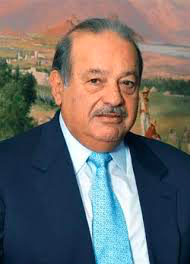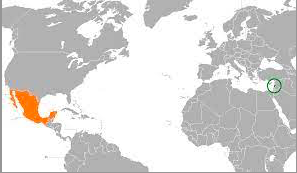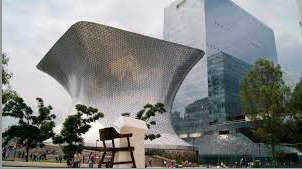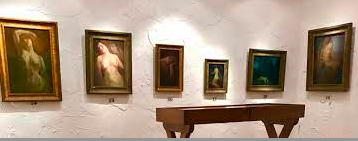Carlos Slim and his Lebanese Heritage

“When you give do not expect to receive. Fragrance clings to the hand that gives the rose”- Carlos Slim
By: María Teresa Fidalgo-Azize/ Arab American Contributing Writer
Self-made business magnate, illustrious civil engineer, owner of the telecommunications corporation América Móvil, and fine art’s lover of Kahlil Gibran poetry and essays, Carlos Slim Hélu epitomizes the eclecticism of the entrepreneurial spirit. A mode d’être which he acknowledges originates from the memory of his late father, Julián Slim Haddad, a Lebanese immigrant who arrived on Mexican soil in 1902 escaping from the Ottoman Empire’s military mandate for boys over the age of 15. Sadly, Julián Slim passed away when Carlos was only thirteen years old, yet his life lessons – family values, investing, and culture- were carried for many years.
Carlos Slim with his traces of Arab ancestry embodies Mexico’s multi-cultural richness. Carlos Slim’s fearless defense of Mexico’s earning and growth potential as a developing country was demonstrated in his reluctance to migrate to the United States amidst the economic crisis in 1984. He trailblazes immigrant excellence and creates a portrait on how there can be two homes: one’s ancestral motherland and one’s adopted homeland. Carlos Slim speaks to all who are part of the Arab diaspora.
Brief History of Lebanese Migration to Mexico

According to Theresa Alfaro-Velcamp’s So Far from Allah, So Close to Mexico: Middle Eastern Immigrants in Modern Mexico, [1]a historical trajectory of the Middle East immigrants relationship to Mexico and the creation of identity, people from the now nation-state of Lebanon[2] began to immigrate to Mexico at the beginning of the 20thcentury escaping the Ottoman Empire. Alfaro divides the migration process into four stages: 1. Often misnomered as “turcos”, Arab people came between 1880 to 1910, 2. Newly arrived Middle Eastern immigrants became merchants during the time of the Mexican Revolution, establishing themselves as providers of goods and essential services (1910-1920), 3. Reunification of the Syrian and Lebanese community (1920s-1930s) and 4. Arrival of World War II refugees and the reconstruction of the Lebanese Mexican community. During these four stages, the Middle Eastern community, specifically the Lebanese community, distinguished themselves as successful merchants, ascending the ladder to elite economic status in Mexico.
Arabic “foreignness” was punished with xenophobic policies during the Great Depression as the financial success of what were considered unwanted immigrants (European immigrants were preferred over Chinese, Japanese, and Middle Eastern) was viewed as detrimental to the national category of Mexicans, regardless of ethnic origin. One of the reasons for which Arabs, particularly Lebanese people, became bastions of the Mexican economy was the concept of payment installments “abonos”, which allowed people from rural communities (campesinos) to participate in the formal economy. In So Far from Allah, So Close to Mexico: Middle Eastern Immigrants in Modern Mexico, there is a debate whether despite Mexico’s rejection of outsider identities, cultural assimilation and integration arose because of Mexico’s mestizaje– thus blurring the ethnic barriers of native and foreign.
An early example of Middle Eastern entrepreneurship in the world of commerce and culture is seen in the figure of Carlos Slim’s grandfather, José Helú, who founded the first printing press in Arabic in Mexico an example of formalizing Lebanese diaspora as belonging to Mexico’s nation building. The imaginary frontiers in identity formation including the concepts of ancestry and national origin fused themselves beautifully in Carlos Slim, a pioneer of Mexico’s economic growth while proudly embracing his heritage.
Carlos Slim Celebrates Arab Heritage with the Soumaya Museum, Mexico City

Soumaya transliterates into English from Arabic as “high above”; it is also the name of Slim’s wife, Soumaya Domit Gemayel. Located in Mexico City, the Soumaya Museum, has three locations: Plaza Loreto, Plaza Carso and Casa Museo Guillermo Tovar. This museum which opened its doors at no cost to the public in 1994 is a non-profit cultural institution part of Fundación Carlos Slim, which has an art collection of an approximate 70,000 pieces highlighting both European and Novo Hispanic artists.

A distinguishing appeal of Soumaya’s Museum to lovers of Arab culture is its extensive collection on the Lebanese born poet and essayist, Gibran Kahlil Gibran, also known as “the poet of exile”. The collection is comprised of unpublished texts, his own death-mask, and the manuscript of “The Madman”. A great part of the collection’s exquisite pieces is owed to the poet’s nephew and godson, Kahlil George Gibran who offered the collection to Carlos Slim in order for this prized material to be in the custody of a reserved cultural space.
The Soumaya Museum is an expression of Carlos Slim’s philanthropy and love for the Mexican people, as he intended to close the gap of access to cultural capital by making it accessible for anyone to participate in the sphere of art: European, Arabic, and Novo Hispano.
Sources
Alfaro-Velcamp, Theresa. So Far from Allah, so Close to Mexico: Middle Eastern Immigrants in Modern Mexico . 1st ed., University of Texas Press , 2007.
Carlos Slim Helú ., 2015, carlosslim.com/biografia_ing.html.
Martinez Piñeiro , Sebastian, director. Gigantes de México. 2017, https://www.youtube.com/watch?v=HxuCnbbbClc.
[1] Former President of Mexico Porfirio Diaz (1886-1911) is attributed of saying “Poor Mexico, so far from God, so close to the United States”. The author details in the book’s introduction that she reintroduces this saying as “So Far From Allah: So Close to Mexico” to broaden the mythic nation-building concept of Mexicanidad (a mixture of indigenous and colonial Spanish) and also detail how for some Middle Eastern immigrants Mexico was a midpoint either to build wealth and return to their native country or then migrate to the United States.
[2] Lebanon was founded as multiconfessional- Sunni-Maronite-Shia- state in 1943 as what is known as the National Pact.
Check out our Blog here.








